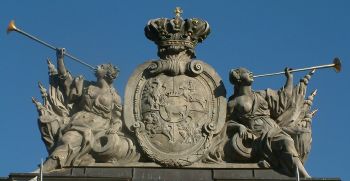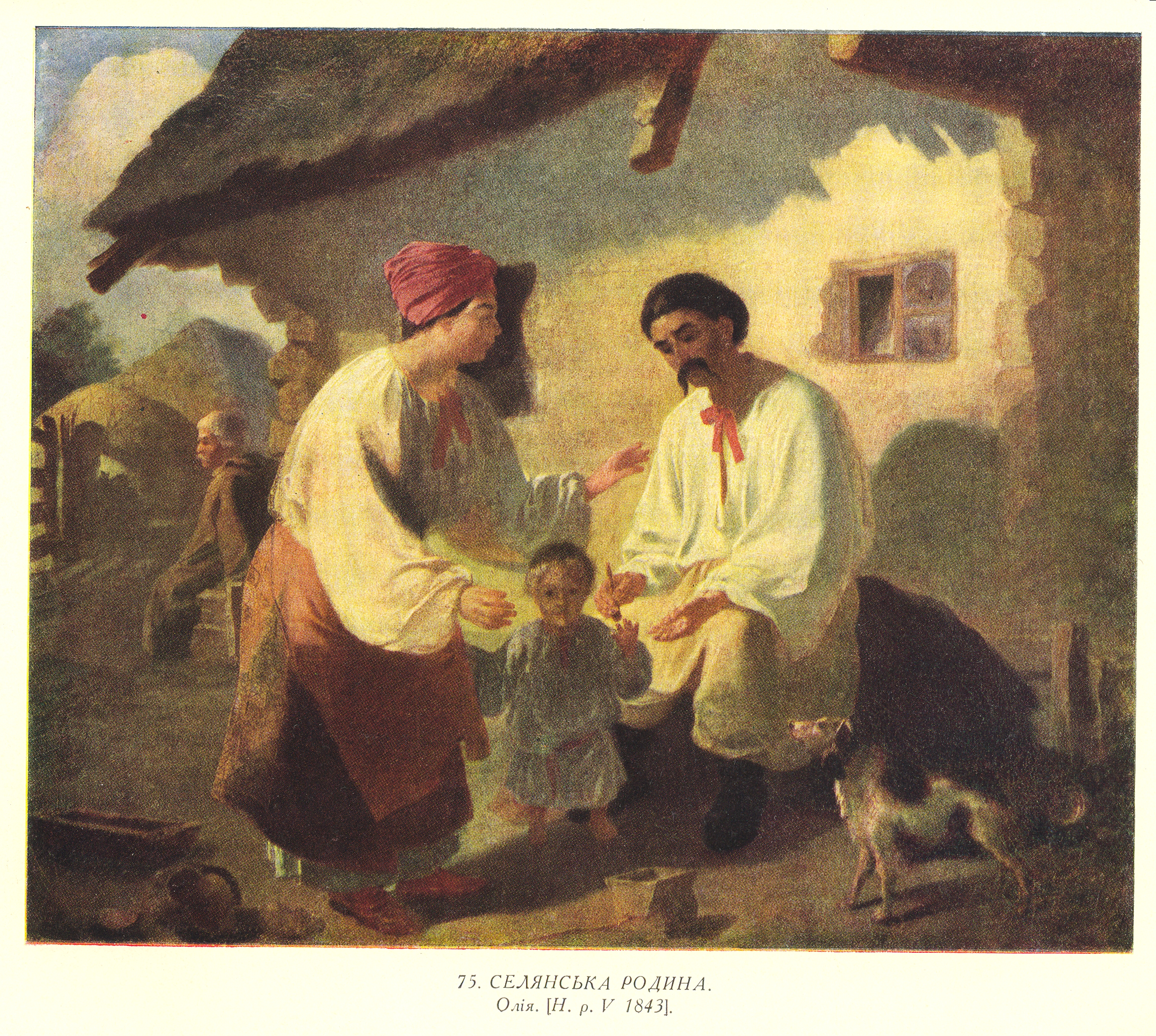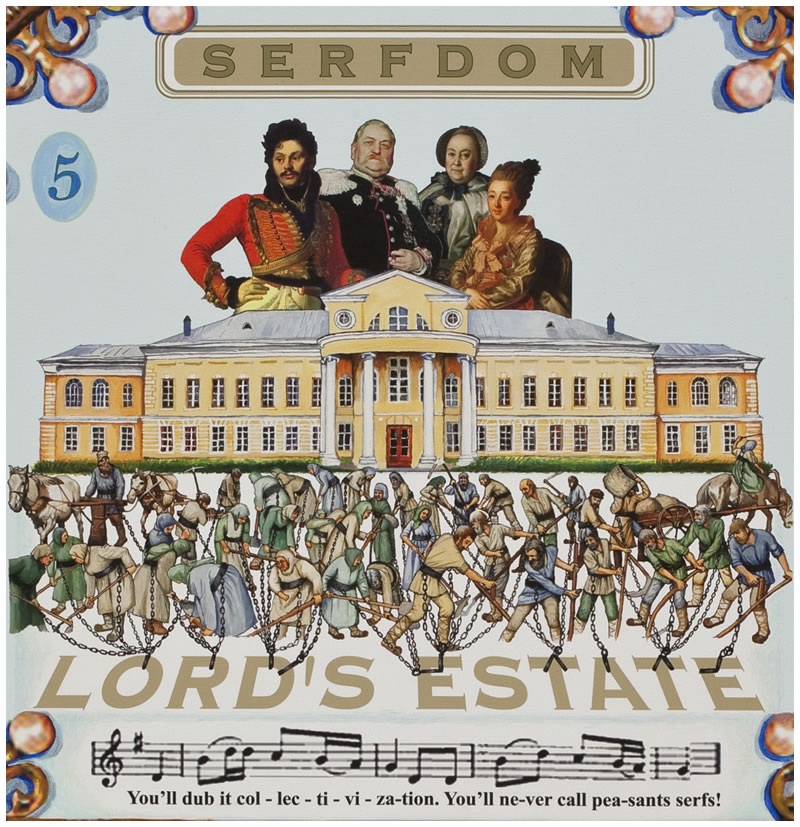 |
| Peasant Children. painting by Vladimir Makovskiy 1890 |
Serfdom in Russia was very much like serfdom in the Polish-Lithuanian
Confederation, but it developed and ended later in Russia than it did in
Poland. Serfs were tied to the land, expected to work a specific number of days
for the landlord and allowed to farm some land for themselves. Serfdom in
Russia, as in Poland, was not connected to feudalism. It developed in both places because the nobility needed a cheap source of labor to work their large estates.
More about serfdom in the Polish-Lithuanian Commonwealth
More about serfdom in the Polish-Lithuanian Commonwealth
Muscovite Russia 1533-1682
Serfdom developed during the Muscovite Period, 1533-1682, on foundations which were laid earlier. The practice was the cornerstone of
Muscovite agriculture and supported the structure of the state. No laws were passed regulating serfs in
the early days, but the government did limit movement of serfs and required that
runaway serfs be returned to the landowner. In 1649 Tsar Alexis issued
an Utoshe, a decree that tied peasants to their landlord’s estates, and
required their labor. The Utoshe confirmed the idea that once a peasant became
a serf, he and his descendants would always be serfs. In Muscovite Russia, the peasant class included serfs,
slaves and state peasants. Peasants could sell themselves into slavery, which
happened during hard times. State peasants worked for the government, not
landlords. As serfdom grew, the
distinctions between serfs and slaves disappeared.
Imperial Russia 1682-1914
Peter II, The Great, enlarged Russian territory during his rule. He put a tax on the male population,
and made paying it the responsibility of the landlord. However, the landlords passed the
tax on to the serfs. As a result of this tax, landlords began to think of their
serfs as property, which could be bought and sold.
During the rule of Peter’s successors, Catherine I, Anne,
and Elizabeth, serfs were forbidden to buy and sell real estate, mills or
factories. They could borrow money only with their landlord’s permission. In
1736, laws were enacted that required serfs to get their landlord's permission to leave the estate for
temporary employment. In
1754, serfs were listed in the criminal code as property of the landowner. Since
Russian serfs, like serfs in the Polish-Lithuanian Commonwealth were attached to the land, when the land was sold, the serfs were
included in the sale. However, in Russia individual serfs could be bought and sold.
Russian territory increased during the rule of Catherine II, The Great. as a result of the Partitions of Poland
(1772-1795), The population
increased by six million people and land by 178,000 sq. miles. Serfdom already
existed in the areas of Poland-Lithuanian Commonwealth acquired by Russia, and Catherine wanted to
expand Russian style serfdom to the new acquired areas. Although Catherine was considered a reformer, her reforms did not improve conditions for the serfs. In 1775, when she reformed
local government, the serfs were overlooked. Rights of the landlords were strengthened and they were acknowledged
as the full owners of their estates without any restrictions. She gave huge
grants of state land and peasants to her supporters and favorites. Serfs were
forbidden to leave estates and to remain in their place and calling. In the
Census of 1794-6, 53% of all peasants and 49% of Russia’s population were
serfs.
Russian serfs owned and farmed their own plots, which were
larger than the plots of serfs in the Austrian Empire. They could also sell their surplus
crops for a profit. If they paid a fee, the “Obrok”, to their landlord, they were allowed to leave the estate to work elsewhere for
wages. By 1857, 67% of serfs were
on the “Obrok.”, which became a source of income for the landlord. One half of Russian peasants were
state serfs who paid a tax to the state and were allowed to leave the
community to find work. They generally were better off than peasants who were privately owned. Landlords could take serfs from the land and use them has servants in their house. House serfs did not work the land and had no plots of land for themselves.
It was possible for serfs to become wealthy, but this was not common. Western European travelers in Russia during the 19th century noticed that Russian peasants appeared to be better off than peasants in France or Ireland, had larger houses, more farm animals and larger plots. Though some Russian serfs were more prosperous than peasants in other areas of Europe, they lacked rights enjoyed by peasants in most other European countries. They had no civil rights and no way to address wrongs inflicted on them by their landowner. They could not leave the landlord's estate without his permission. They could be exiled to Siberia for bad behavior. Some had to get the lord's permission to marry. They could be bought and sold. Their lives were totally subject to the will of their owner.
 |
| Peasant Children. Photograph by William Carrick, 1860 |
It was possible for serfs to become wealthy, but this was not common. Western European travelers in Russia during the 19th century noticed that Russian peasants appeared to be better off than peasants in France or Ireland, had larger houses, more farm animals and larger plots. Though some Russian serfs were more prosperous than peasants in other areas of Europe, they lacked rights enjoyed by peasants in most other European countries. They had no civil rights and no way to address wrongs inflicted on them by their landowner. They could not leave the landlord's estate without his permission. They could be exiled to Siberia for bad behavior. Some had to get the lord's permission to marry. They could be bought and sold. Their lives were totally subject to the will of their owner.
Serfdom Ends in Russia
Attitudes toward serfdom began to change during the 19th
century. Many Russians believed that serfdom was inhumane and should be done
away with. The Crimean War showed
that there problems in Russian
society and changes were necessary. In 1856, Tsar Alexander
II said “Better to abolish serfdom from above than wait until it abolishes
itself from below.” When he came to the throne in 1858, 37% of all Russians
were serfs.
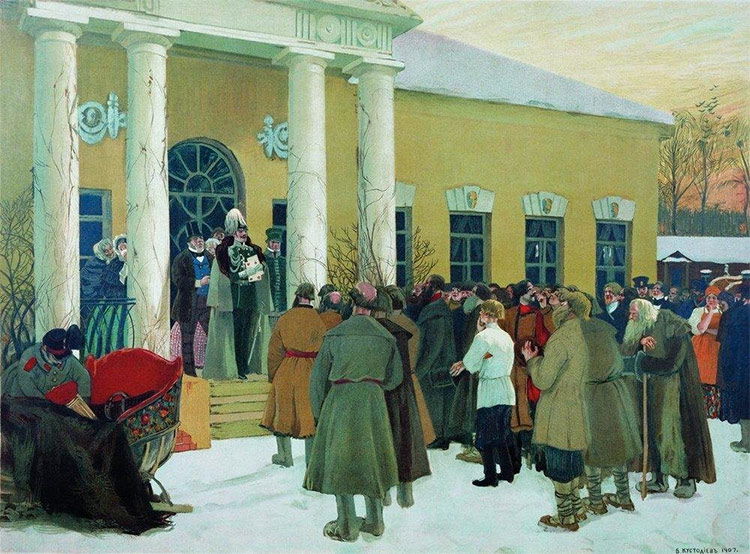 |
| "Reading the Manifesto." painting by Boris Kustodiev, 1907 |
 |
| Tsar Alexander II |
The serf was now free and owned his land. The provisions of the emancipation were designed to protect the interests of the landlords as well as those of the peasants. The landlord retained about half of estate’s land, the peasants received the other half. The average size of peasant plots was about 27 acres in the Russian Empire, 18 acres in the parts of Ukraine, which were acquired in the Partitions of Poland. The landlords were compensated by the sale of government treasury bonds, which were to be paid for by the former serfs over a period of 49 years. The former serfs continued to pay the head tax, even though it was no longer paid by other Russians.
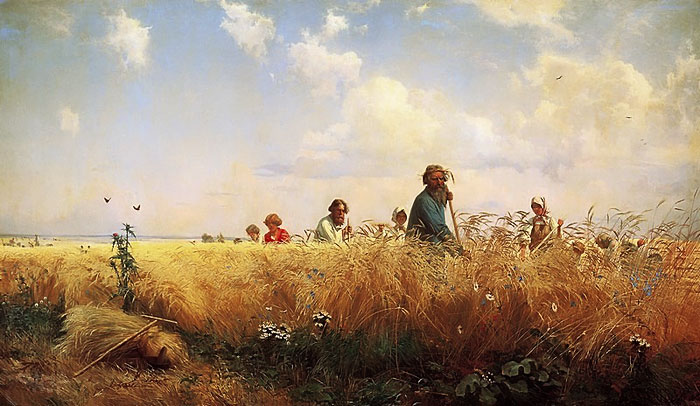 |
| "Harvesting" painting by G. Myasoyedov 1887 |
The emancipation benefited the landlords more
than the peasants. Serfs received land, but not enough. Their new land
allotment was 10% to 40% smaller than what they had before emancipation, depending on where in
Russia they lived. In most areas, the land was given to the village commune (Mir), not to individual peasants. The Mir divided the land and paid the taxes.
Peasants were free, but still had restrictions on their movement. They were
still tied to their communes, they were judged by customary law. Only serfs who worked the land received
land, household serfs got nothing. State peasants received larger land grants and fared better than peasants on the land
of private owners.
Peasants in Ukraine, which came to Russia in the Polish Partitions, did
not have a tradition of communes, the land was owned by individuals, so they continued to own their own plots.
 |
| Peasant Girls. photo by Prokudin-Gorsky, Library of Congress. |
Emancipation was a compromise, serfs had freedom, but not
full equality. They had land, but
not enough. Many were dependent on their former landlords.
Unlike the Austrian-Hungarian Empire, where free public education was provided for former serfs, no provisions were made their education in Russia. Unable to better themselves in Russia, many chose to leave and immigrate to the United States, Canada and the countries of South America.
Sources:
The Internet Encyclopedia of Ukraine, www.encyclopediaofukraine.com
Conquest, Robert, The Harvest of Sorrrow, New York, 1986.
Pipes, Richard, Russia Under the Old Regime, New York, 1974.
Plokhy, Serhii, The Gates of Europe, New York, 2015.
Riasanovsky, Nicholas, A History of Russia, New York, 1963.
Subtelny, Orest, Ukraine, A History, Toronto, 1988.
Sources:
The Internet Encyclopedia of Ukraine, www.encyclopediaofukraine.com
Conquest, Robert, The Harvest of Sorrrow, New York, 1986.
Pipes, Richard, Russia Under the Old Regime, New York, 1974.
Plokhy, Serhii, The Gates of Europe, New York, 2015.
Riasanovsky, Nicholas, A History of Russia, New York, 1963.
Subtelny, Orest, Ukraine, A History, Toronto, 1988.




